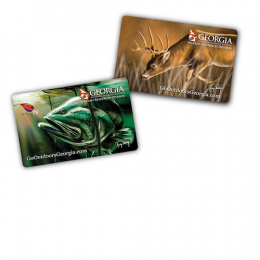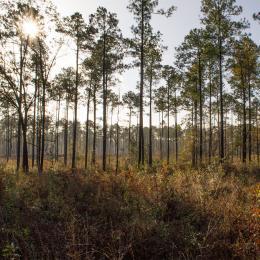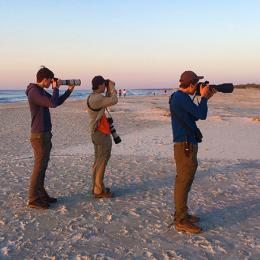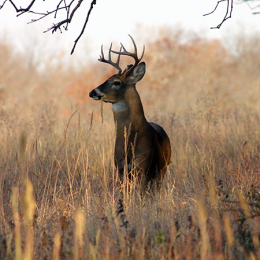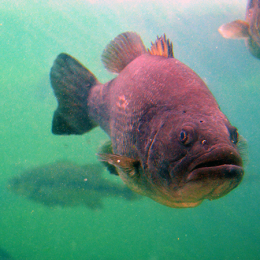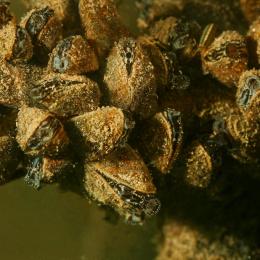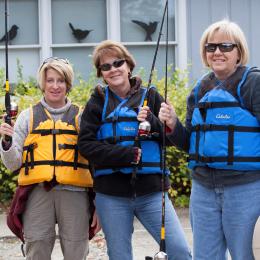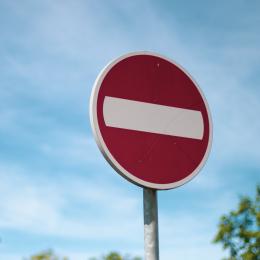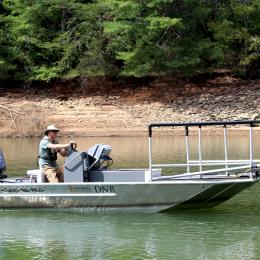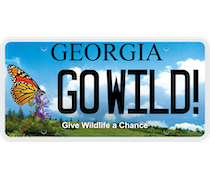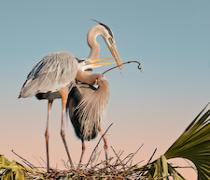.jpg)
A male bluebird at its nest (Terry W. Johnson)
By Terry W. Johnson
One spring morning a decade or so ago, I tried to photograph a pair of bluebirds bringing food to their hungry young nestled inside a nesting box in my backyard.
I set my camera up early that morning at a safe distance from the nest hoping to take advantage of what photographers call the golden hour – that special time early in the morning or late in the afternoon when the sunlight bathes everything it touches with an extremely flattering golden hue.
As I watched the birds bringing tiny caterpillars to their voracious young, the return of the male was something to behold. Each time the bird would fly up to the box with a hapless caterpillar, it would land at the entrance hole with its back and tail facing me, take a glance my way, and then disappear through the hole in the box. During the precious few seconds the bird hesitated before entering the box, the golden sunlight made the bird's feathers appear to almost glow.
After photographing the bird returning to the nest box several times, for some reason I recalled the time years before when I learned that a bluebird is not actually blue. I distinctly remember the odd feeling that sweeps over you when you learn that something that you have long considered fact is not true at all. It’s like discovering that George Washington didn't actually cut down a cherry tree or that handling a toad doesn't cause warts.
The famous early American naturalist Henry David Thoreau obviously thought the bluebird is blue when he wrote "The bluebird carries the sky on its back." The scores of birding field guides on the shelves of my library concur that the bluebird is indeed blue.
Yet, in truth the bluebird’s feathers are actually grayish brown. Years ago a scientist found that when he ground up a bluebird's feathers they were no longer blue. In contrast, he discovered that ground up cardinal feathers retained their red color. This begs the question: How can that be?
The answer is that cardinal feathers contain a red pigment, but bluebird feathers do not have blue pigments. In fact, no bird in the entire world has a single blue feather. It's true: You cannot find blue plumage on a blue goose, blue-winged teal, black-throated blue warbler or even a blue jay.
It seems that physicists call the bluebird's color a schemochrome color, sometimes also referred to as a structural color. Here is how it works: The surface of the bluebird's feathers are very smooth. When sunlight passes into these feathers it encounters countless structures that contain air pockets and cells layered atop brownish pigment cells within the feathers’ barbs. This structure causes the light's blue rays to bend. When these wavelengths are reflected back to our eyes, our brain then interprets the color of the bird as blue.
In the eyes of many people that enjoy gazing upon or photographing a male eastern bluebird, the brightness of the bird's plumage is most important. They perceive the males with the brightest plumage as being the most beautiful. Although some males are going to naturally appear bluer than others, the direction and intensity of the light affects how blue the bird appears. For this reason, a male bluebird perched in the shadows can often appear to completely lose its blue color.
Researchers have found that color is of paramount importance to female bluebirds, too. A study conducted by a biologist at Appalachian State University in Boone, N.C., tried to determine whether or not the male's plumage affected breeding success. She found that male bluebirds that sported the most stunning blue plumage proved to be the most successful in attracting mates.
I have long recovered from learning that a bluebird's color is an optical illusion. In fact, I, for one, don't look at the bluebird any differently now than I did before I learned this bird isn't technically blue. What matters most to me is that I will always enjoy the sight of a bluebird, whether it be a brightly-colored male, a drab female or a speckle-breasted fledgling.
Now that I have explained why the bluebird is not blue, I hope you will feel the same way.
Terry W. Johnson is a retired Georgia DNR program manager and executive director of The Environmental Resources Network, or TERN, the friends group of DNR’s Wildlife Conservation Section. Check out past columns, his Backyard Wildlife Connection blog and his book “A Journey of Discovery: Monroe County Outdoors.” Permission is required to reprint a column.






